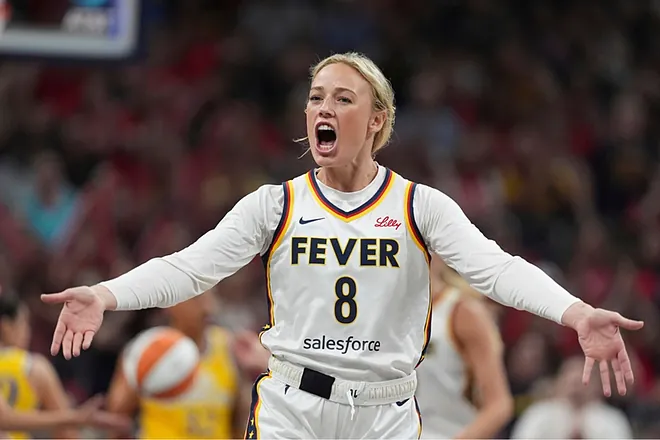The recent announcement of the WNBA’s expansion plans has stirred a whirlwind of reactions across the league, but few responses have been as pointed and damning as that of Indiana Fever star Sophie Cunningham. As the league prepares to broaden its footprint, Cunningham’s sharp critique cuts through the excitement, shedding light on concerns that many fans, players, and insiders have quietly harbored about the future direction of the women’s professional basketball league.
Sophie Cunningham, known for her tenacity and leadership on the court, did not hold back in voicing her skepticism and frustration about the expansion strategy. Her comments, which quickly circulated through social media and sports news outlets, have ignited an intense debate over whether the WNBA’s approach truly prioritizes the welfare of its players, the quality of the competition, and the sustainability of the league’s growth.
At the heart of Cunningham’s critique is a challenge to the timing and rationale behind adding new teams. Expansion in sports is often viewed as a positive sign—a marker of growth, popularity, and financial success. Yet Cunningham’s perspective suggests that the WNBA may be moving too quickly without sufficiently addressing underlying issues that have long impacted the league. These include questions around player salaries, team resources, travel logistics, and the overall support infrastructure that players rely on.
Cunningham expressed concern that the rush to add more teams could dilute the talent pool, potentially lowering the quality of play. The WNBA, while growing in stature, still operates with a relatively limited number of elite athletes compared to larger men’s leagues. Adding new franchises requires either drawing from an already small talent base or hastening the development of rookies who may not yet be ready for the professional level. Cunningham warned that this might hurt the product on the court, which could alienate fans and ultimately stunt long-term growth rather than encourage it.
Beyond the competitive aspects, Cunningham highlighted financial and operational realities. Players across the league have historically faced challenges with relatively low salaries compared to their male counterparts, limited benefits, and inconsistent support from some franchises. The introduction of new teams without a clear, equitable financial model could exacerbate these problems. Cunningham’s critique pointed out that without significant investments in player compensation and welfare, expansion could come off as a superficial growth tactic rather than a meaningful step toward true league advancement.
The Indiana Fever star’s comments also touched on the broader cultural and societal implications of the WNBA’s expansion. The league has been a trailblazer in advocating for women’s sports and equality, yet Cunningham suggested that expansion should not simply be about market size or TV ratings. It should reflect a commitment to strengthening the community, improving opportunities for women athletes, and ensuring that every new franchise is built on a foundation of sustainability and respect for players’ needs.
Her statements sparked a varied response from fans, analysts, and league officials alike. Supporters of the expansion argued that growing the league is essential to increasing visibility and financial viability. They pointed to recent surges in attendance, viewership, and sponsorship deals as evidence that the WNBA is on the cusp of a new era of prominence. For them, expansion represents an opportunity to bring professional women’s basketball to new cities, create jobs, and inspire the next generation of female athletes.
On the other hand, many echoed Cunningham’s cautionary stance, urging the league to slow down and address the systemic issues that could undermine its future success. They stressed that expanding too fast without solid infrastructure could backfire, leading to overextended franchises, poor fan experiences, and frustrated players. These voices emphasized that sustainable growth requires comprehensive planning, enhanced player support, and a long-term vision that balances commercial ambitions with the realities of professional women’s basketball.
The WNBA’s front office has responded by reiterating its commitment to both growth and player welfare. League executives acknowledged the concerns raised by Cunningham and others, promising to work closely with players’ associations and franchise owners to ensure that expansion benefits everyone involved. They have highlighted recent steps toward increased player salaries, improved travel standards, and better health care provisions as signs of positive momentum.
However, the tension between rapid expansion and maintaining league quality remains palpable. Cunningham’s outspoken stance has brought to the forefront questions about what it means to grow a professional women’s sports league in today’s environment. How can the WNBA balance ambition with prudence? What measures are necessary to ensure that new teams are competitive, financially viable, and supported by their communities? And perhaps most importantly, how can the league ensure that players—who are the heart of the sport—are not sidelined in the pursuit of growth?
This debate reflects a larger conversation happening across women’s sports, where many leagues are grappling with how to leverage rising popularity into sustainable success. The WNBA, as one of the premier women’s professional leagues in the world, is both a leader and a case study in this challenge. Cunningham’s critique, though critical, is ultimately a call for thoughtful, player-centered expansion that honors the hard work and passion that have made the league what it is today.
As the WNBA moves forward with its expansion plans, the impact of Cunningham’s voice will likely be felt in boardrooms, locker rooms, and fan discussions alike. Her willingness to challenge the status quo underscores the importance of listening to players, not just as athletes but as advocates for the future of their sport. The league’s ability to navigate these complex dynamics will determine whether expansion is a moment of triumph or a cautionary tale.
In the end, Sophie Cunningham’s damning response serves as a crucial reminder: growth for growth’s sake is not enough. The WNBA’s expansion must be measured, inclusive, and deeply connected to the values that have propelled women’s basketball forward. Only then can the league truly soar to new heights, delivering on the promise of opportunity, excellence, and equality for generations to come.



